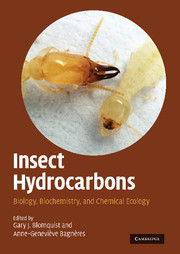Book contents
- Frontmatter
- Contents
- List of contributors
- Foreword
- Acknowledgments
- Part I Chemistry, Biochemistry, and Physiology
- 1 Introduction: history and overview of insect hydrocarbons
- 2 Structure and analysis of insect hydrocarbons
- 3 Biosynthesis of cuticular hydrocarbons
- 4 Molecular biology and genetics of hydrocarbon production
- 5 Site of synthesis, mechanism of transport and selective deposition of hydrocarbons
- 6 Cuticular lipids and water balance
- 7 Chemical taxonomy with hydrocarbons
- 8 Chemical synthesis of insect cuticular hydrocarbons
- 9 Oxygenated derivatives of hydrocarbons
- Part II Chemical Communication
- Index
9 - Oxygenated derivatives of hydrocarbons
from Part I - Chemistry, Biochemistry, and Physiology
Published online by Cambridge University Press: 18 May 2010
- Frontmatter
- Contents
- List of contributors
- Foreword
- Acknowledgments
- Part I Chemistry, Biochemistry, and Physiology
- 1 Introduction: history and overview of insect hydrocarbons
- 2 Structure and analysis of insect hydrocarbons
- 3 Biosynthesis of cuticular hydrocarbons
- 4 Molecular biology and genetics of hydrocarbon production
- 5 Site of synthesis, mechanism of transport and selective deposition of hydrocarbons
- 6 Cuticular lipids and water balance
- 7 Chemical taxonomy with hydrocarbons
- 8 Chemical synthesis of insect cuticular hydrocarbons
- 9 Oxygenated derivatives of hydrocarbons
- Part II Chemical Communication
- Index
Summary
Arthropod waxes (complex mixtures of long-chain-carbon compounds) include straight-chain saturated and unsaturated hydrocarbons, methyl-branched hydrocarbons and more polar lipids that contain one or more oxygen functional groups on long aliphatic carbon chains that include wax esters, sterol esters, ketones, alcohols, aldehydes and acids for Insecta (Lockey, 1988; Buckner, 1993; Nelson and Blomquist, 1995) and Arachnida (Chapters 7 and 16, this book). As a major lipid class, hydrocarbons are present in the cuticular extracts of virtually all insects studied and there have been previous reviews on their occurrence, identification, biosynthesis and function (Jackson and Blomquist, 1976; Blomquist and Jackson, 1979; Blomquist and Dillwith, 1985; Blomquist et al., 1987; Lockey, 1988; Blomquist et al., 1993; Howard, 1993; Nelson and Blomquist, 1995; Howard and Blomquist, 2005). This chapter focuses on the occurrence, structural identification and function of those hydrocarbons that possess one or more oxygenated functional groups that include: ethers, epoxides, ketones, secondary alcohols, and their esters. These lipid classes represent hydrocarbon derivatives in which oxygen was biosynthetically introduced onto a non-terminal carbon(s) of long-chain hydrocarbons. Other lipid classes included in this review are long-chain methyl-branched primary alcohols and those wax esters with either ketone groups or methyl branches on their acid and/or alcohol moieties. This review does not include those oxygenated insect lipids not derived from pre-formed hydrocarbon constituents: long-chain fatty acids, primary alcohols, aldehydes, wax esters (esters of long-chain alcohols and long-chain acids), sterols, sterol esters, and mono-, di- and triacylglycerols.
- Type
- Chapter
- Information
- Insect HydrocarbonsBiology, Biochemistry, and Chemical Ecology, pp. 187 - 204Publisher: Cambridge University PressPrint publication year: 2010
- 12
- Cited by



